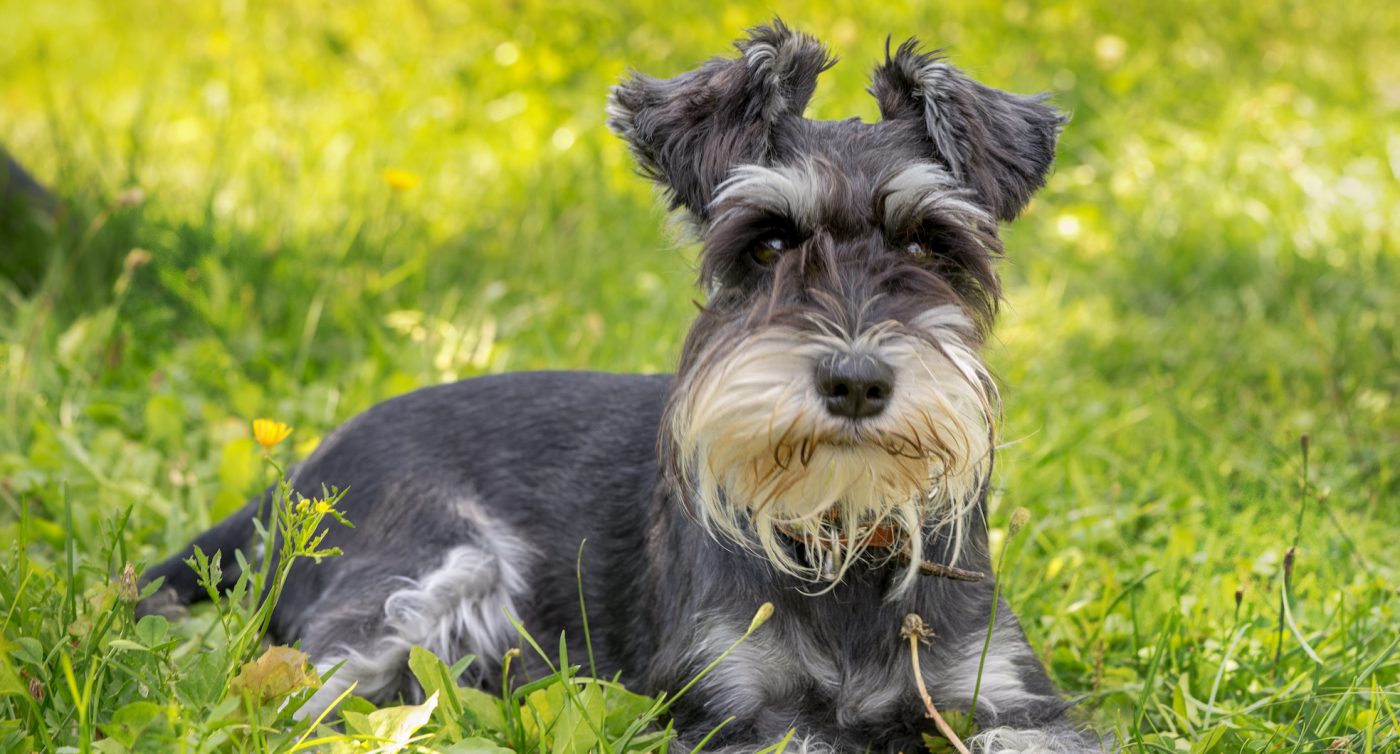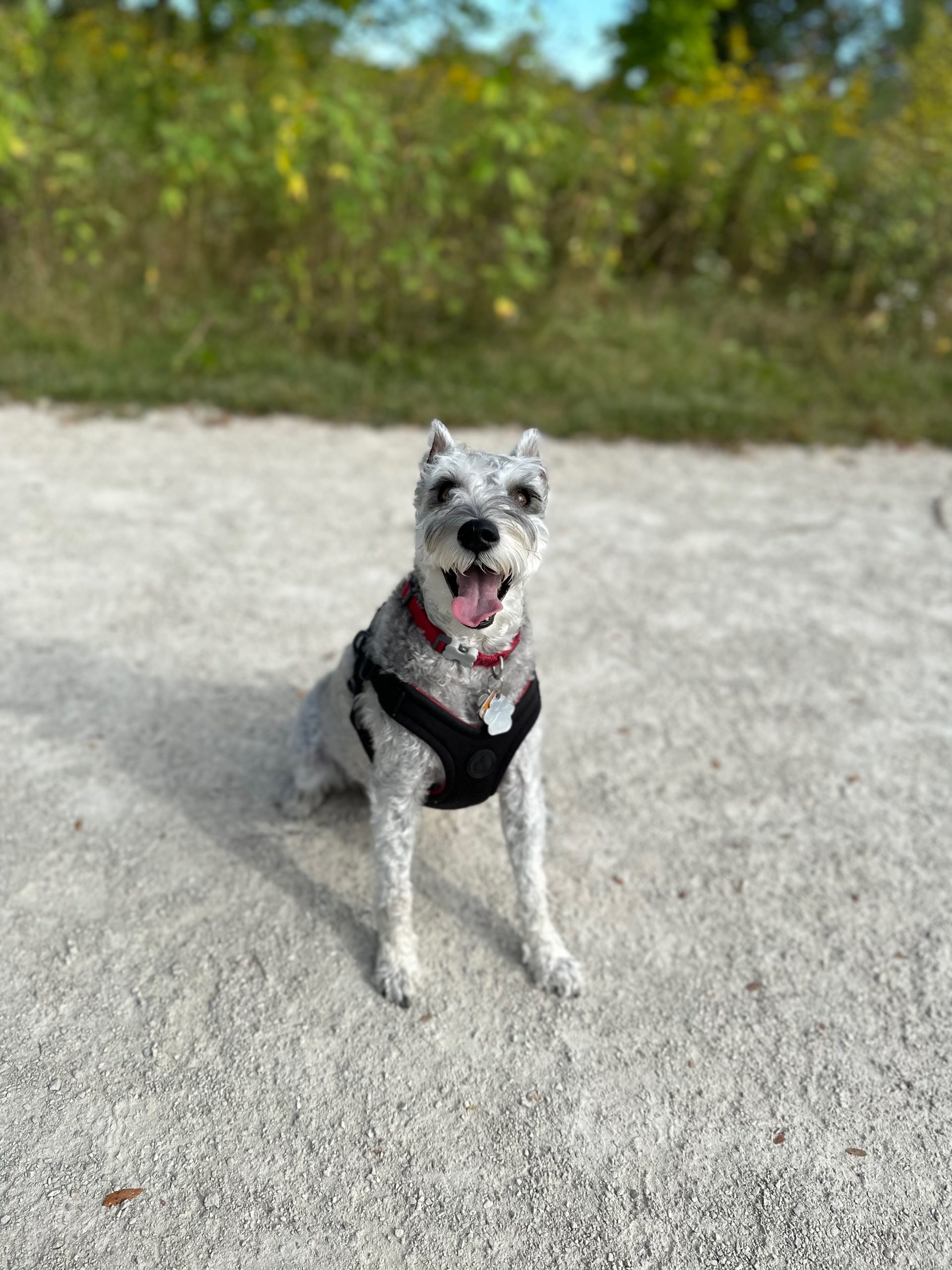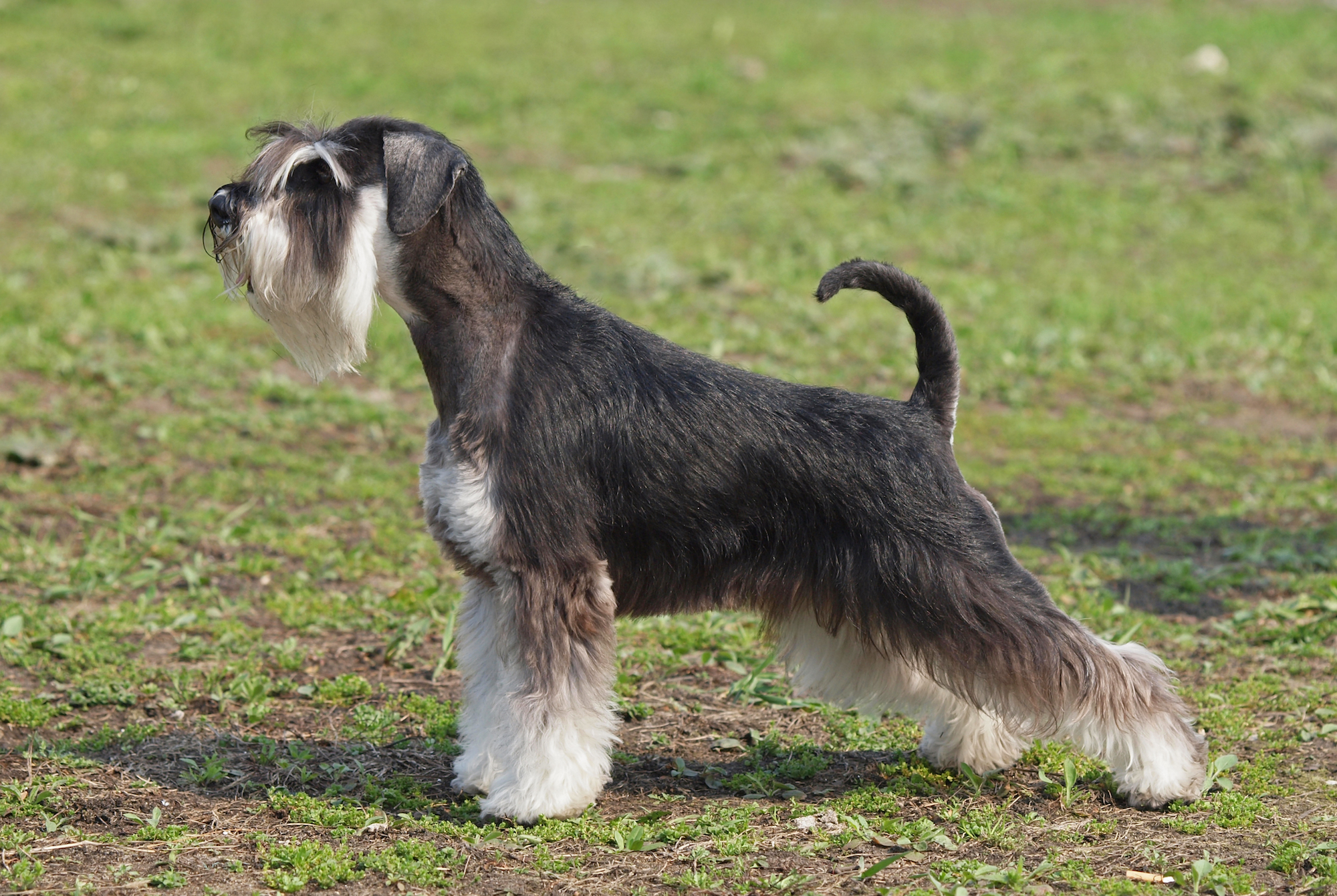Robust and sturdy, with a wiry coat and bushy eyebrows, there’s no mistaking a schnauzer, whether standard, miniature or giant. Named for one of their most distinctive features–”schnauz” means mustache or snout in German–these curious, busy dogs are full of personality. Schnauzers are loving companions, but they also can be fearless protectors (yep, even the minis), and they will let you know how they feel… loudly.
With ample training and exercise, these intelligent, active dogs can make fun family companions. Here’s a guide for anyone considering bringing a schnauzer home, or looking to better understand the one they already have.
Schnauzers: The basics
Both miniature and giant schnauzers were developed from standard schnauzers, which date back to the Middle Ages. Standards weigh 35 to 45 pounds and hit 18 to 20 inches at the shoulder, while miniatures reach 11 to 20 pounds and 12 to 14 inches, and giants 55 to 85 pounds and 24 to 28 inches. All three can be black or salt and pepper; miniatures are sometimes black and silver, and giants can also have tan in their coats. Though, size apart, they look similar and share many characteristics, the American Kennel Club considers them three different breeds. Miniature schnauzers are in the AKC’s terrier group, while standards and giants are part of the working group.
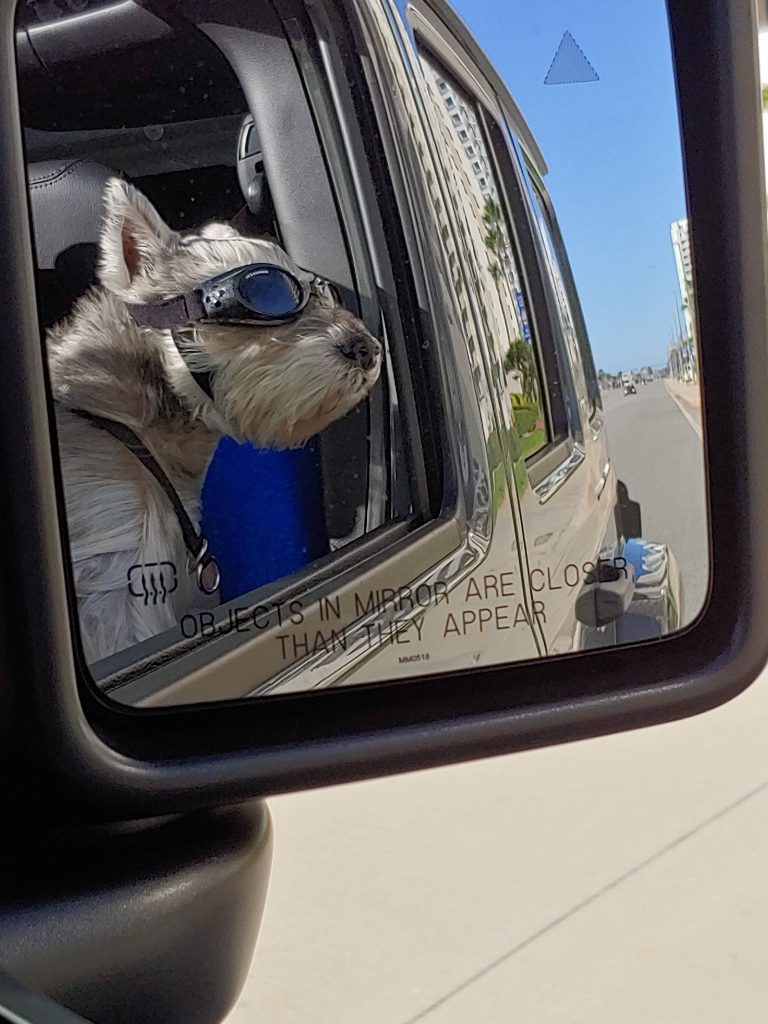
Pip
Schnauzer personality
“Schnauzers have huge personalities,” says Jamie Hayen of her schnauzer Otis. “They’re like toddlers. They have serious sass and don’t hold back in letting you know exactly how they feel. And, when they want something, they want it right now.”
No matter what they’re feeling, schnauzers will express it. “Schnauzers have a range of sounds they make, from low grumbles to mid-range wails and standard woofs, all the way up to high-pitched screams,” says Caitlin Luetger-Schlewitt of her dog, Bowser. “Sometimes these sounds can come out as screaming or singing, depending on who he is trying to communicate with.”
Alert, active, smart, and sometimes mischievous, schnauzers are definitely entertaining, but they are not the dogs for folks who prize mellowness in their pup.
“Miniature schnauzers are such characters,” says Angela Bryant, co-director of the Almost Home Schnauzer Rescue, based in Indianapolis. “They are smart, loyal, and loving companions who bond tightly with their humans. They know what they want, and they’re not afraid to give you a huff, a snort, or a tap with their paw to let you know that they’re in need of a treat or a belly rub. They are characters indeed, and once you invite one into your home, the definition of ‘home’ changes.”
Though they can be a lot of fun, their big personalities can be challenging. “Schnauzers are highly intelligent, but have a mind of their own, and can be a bit stubborn,” says dog trainer Dina Casellini, founder of Mindful Pups in Brooklyn. “This intelligent, versatile breed needs a job. If you don’t train them on what to do, they will find something to do–and it probably won’t be to your liking.”
Schnauzers need plenty of mental and physical exercise daily, they enjoy games and other challenges, and they want to be with their people.
“They love to be lap dogs regardless of their size—6 pounds to 20 pounds!” says Amy Dufala, who lives with multiple schnauzers. “They will be glued to their human’s side, and will trip you up if you’re not looking down as you walk around.”
If you are family or friend to them, schnauzers tend to be playful, affectionate, and loyal. But schnauzers also can be fierce protectors. Though all dogs are individuals, in general schnauzers are gentle with children but may be inclined to bark at unfamiliar dogs and strangers.
“Gretl thinks she is a guard dog, defending me and her home,” says owner Robin Tidwell. “Who needs a doorbell when you have a schnauzer? Gretl will make sure I know if anyone or anything comes within a mile radius of our home.”
Responsible schnauzer guardians will spend a lot of time on socialization and training to keep their assertive companions from becoming ill-tempered or over-protective.
“Schnauzers are unaware of their size. They are devoted protectors and will square up with any sized animal,” says Julio Lujano, dad to Sir Henry Templeton. “They are also incredibly delicate with children and smaller dogs. They are obsessed with their owners. Oh, and they’re defiant like children—side-eye and bark-backs on the daily.”
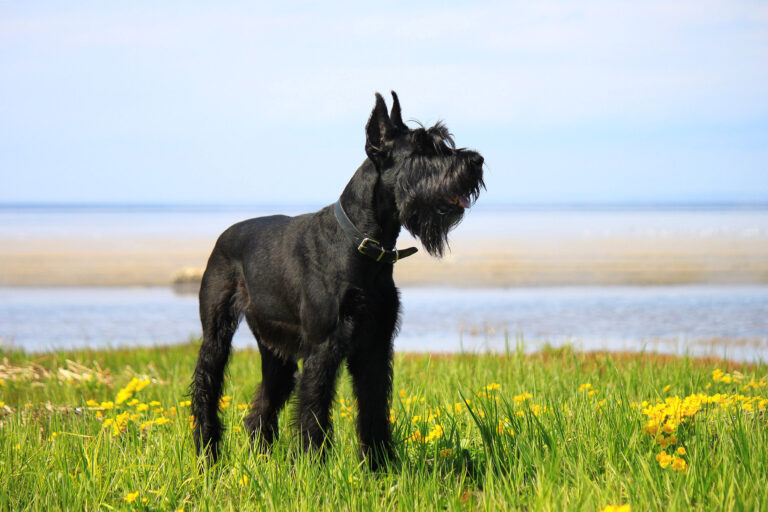
Giant schnauzer
Breed history
Standard schnauzers worked in homes and on farms in what is now Germany beginning in the Middle Ages, herding and guarding livestock, protecting the family at home and while traveling, and hunting rodents.
These prized dogs were crossed with larger breeds such as mastiffs to create giant schnauzers beginning in the 10th century. They served as livestock herders, and, thanks to their natural inclination to guard, in cities they kept watch over breweries, butcher shops and other businesses. These days, some giant schnauzers work with police departments and even the Department of Defense.
Miniature schnauzers are the result of crossing standard schnauzers with smaller breeds such as affenpinschers, and became known as a distinct breed around 1899. They were used on farms to root out rats and other rodents. Those thick whiskers and beards that make schnauzers so distinctive also protected them from the bites of the rodents they hunted.
Schnauzer training tips
Don’t wait for your schnauzer to begin developing bad habits before you start training. “Train your schnauzer early,” Casellini says. “Use reward-based training, and keep the format consistent but not overly repetitious.”
With a vocal breed like schnauzers, it’s important to focus training on barking–especially if your schnauzer is barking to get you to prepare her food faster, or to make some other demand. “When you don’t desire barking, ignore barking and reward silence, then teach them an alternate behavior,” Casellini says.
Because schnauzers are so smart and aware of their surroundings, having a consistent routine is important, Casellini adds.
Exercise for schnauzers
Get ready for action: Schnauzers need at least 45 to 60 minutes of exercise per day. Their desire to be busy isn’t a surprise, since schnauzers were bred to work, hunting, ratting, herding and providing other help on farms. If left to run around in a yard, you may find them digging to root out small animals. They’re good on hikes, and, since they love a challenge and need plenty of mental exercise as well, you can try them on agility training.
“Gretl can go for hours playing fetch,” Tidwell says. “When you stop throwing the ball, don’t think fetch is over for Gretl. She always decides when fetch is over because she eventually starts playing fetch with herself! She will play fetch with herself all night, or at least until we make her come in for the evening.”
Of Bowser, Luetger-Schlewitt says, “He has a lot of energy and loves to play games that stimulate his mind. Schnauzers are very smart, and he loves puzzles and playing tricks on us.”
With their athleticism combined with intelligence, “Fun daily exercise options can include agility or obstacle courses, frisbee, running, biking, tug, fetch, or the flirt pole,” Casellini says.
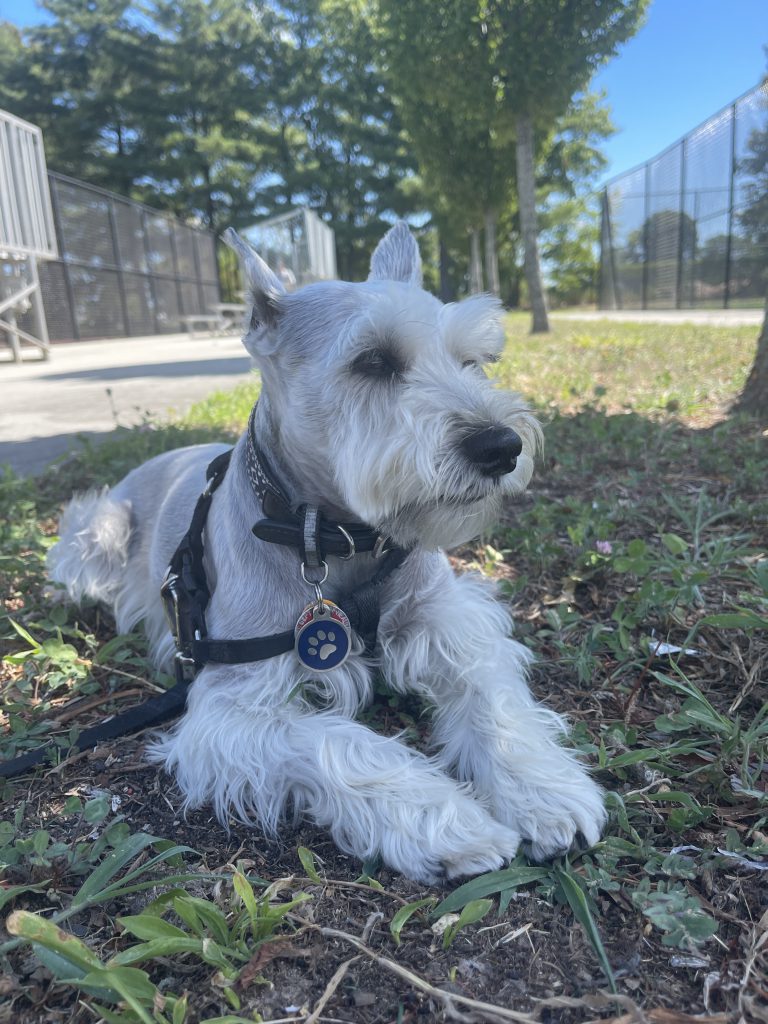
Charlie
Grooming
Schnauzers have two layers of fur; a soft, downy inner layer, and a thicker, wiry outer layer. Though shedding isn’t a big issue with schnauzers, they do require daily brushing and grooming every 4 to 6 weeks to keep their wiry outer fur from matting. As such, “conditioning them for cooperative care should start right away,” Casellini notes.
The signature schnauzer cut is shorter on the top and sides of the body, as well as the head and ears, and the space between the eyes. The hair or “furnishings” on the legs can be long or short, and on the face, the sides are left long, so you get that schnauzer beard-and-eyebrow combo.
Aside from regular grooming, schnauzers need baths roughly every 4 weeks. Plus, you may need to clean and brush out their beard if it gets dirty or tangled.
Common health concerns for schnauzers
Schnauzer comedone syndrome: Also known as “schnauzer bumps,” this is most common in miniature schnauzers. Small bumps like blackheads break out on the dog’s back and neck, caused by the pores becoming clogged with oil and debris. The condition is not curable, but easily managed. It’s important to seek treatment for this condition—treatments usually involve benzoyl peroxide, special anti-seborrheic shampoos, or, in more severe cases, oral retinoids. Untreated, pups can be susceptible to secondary skin infections.
Pancreatitis: Miniature schnauzers are also prone to this condition, which is inflammation of the pancreas. The pancreas is the gland that produces enzymes that facilitate digestion and help the body absorb fats and nutrients and manage blood sugar. When it becomes inflamed, it can cause pain, irritation and damage to the pancreas and surrounding organs. Miniature schnauzers are predisposed to trouble metabolizing fats, so they are vulnerable to pancreatitis. It can show up in an array of symptoms, including lethargy, loss of appetite, vomiting, diarrhea, abdominal pain, and fever. If your dog displays any of these symptoms, see a vet right away. Treatments may include IV fluids, a special diet or feeding your dog smaller meals more frequently.
Urinary stones: Though any dog can have these rock-like mineral formations in their kidneys, bladder or other part of the urinary tract, mini schnauzers are especially susceptible, males more than females. The type of stones commonly seen in mini schnauzers are calcium oxalates. The stones can cause irritation, infection or even blockage, and they often recur. Your dog may experience pain or difficulty when urinating, or you may spot blood in their urine. See your vet right away, especially if your dog can’t urinate or only gets out a few drops at a time, since this indicates a blockage which can cause a rupture and even death within a matter of hours.
The condition is usually diagnosed via X ray/ultrasound of the abdomen. Treatments include surgery, or flushing out the stones with a catheter.
Hip dysplasia: Hip dysplasia is a serious condition that can cause pain, hinder a dog’s mobility, and lead to arthritis. It occurs when the hip joint’s ball-and-socket connection doesn’t fit together smoothly. Giant schnauzers, like other large dogs, are susceptible. Keep your dog at a healthy weight and lean body condition to reduce strain on joints. Tell your vet if your giant schnauzer is newly struggling to walk or climb, which could indicate that the hip is difficult to move or is hurting. The condition is generally inherited—deal with only responsible breeders and rescue organizations—but injury may also be a factor. Treatment options include weight loss, pain medication, nutritional supplements to support joint health, and hip-replacement surgery.
Diabetes: Miniature schnauzers are more prone to developing diabetes than many other breeds, which means their body’s cells have trouble taking and using sugar from the bloodstream, allowing for an increase in blood sugar levels. Symptoms include increased thirst, increased urination, and unexplained weight loss. If your mini schnauzer has any of these symptoms, consult your vet immediately. The only treatment is regular insulin injections, though you may also be able to manage their diabetes with diet.
Pulmonary stenosis: Miniature schnauzers are at risk for this congenital heart defect, in which the blood flowing out of the right side of the heart is obstructed, often by a narrowed valve. Many dogs don’t show signs of illness, though some may have stunted growth. Fatigue, difficulty breathing, and fainting during exercise might indicate pulmonary stenosis. If your vet hears a heart murmur during a checkup, she may pursue an X ray or ultrasound to diagnose this condition. If it’s mild, a dog could live a full and normal life; severe cases may require surgery.
Eye issues: Dogs of any breed can experience eye issues, but schnauzers are prone to the following:
- Cataracts: Of the three types, miniature schnauzers are most susceptible to this condition. Early onset of cataracts is due to a mutation. Cataracts from metabolic disease develop later in life. As cataracts develop, the eye’s lens gradually becomes hazy, clouding vision and eventually leading to blindness. Treatment options include surgery, which is often successful. Many schnauzers develop cataracts due to metabolic disease; keeping your dog at a healthy weight with good blood sugar control can help prevent this issue.
- Progressive retinal atrophy: This is an inherited condition with few treatment options. PRA is a degenerative disease that attacks the cells of the retina, leading to reduced vision and blindness. Responsible breeders will screen for PRA. Watch out for redness, excess tears, night-vision loss, and changes to the lens. Call your vet if the dog paws at their eyes or seems to have trouble seeing.
- Glaucoma: Giant schnauzers are prone to this disease, in which high pressure in the eye damages the optic nerve and retina. This can lead to reduced vision and blindness. Symptoms include eyeball protrusion, redness, pain, and light sensitivity.
Food and nutrition for your schnauzer
All dogs need digestible, complete, and balanced food that supplies enough energy for daily activities and nutrients for long-term good health–and your super-active, curious schnauzer is no exception. Here’s what you need to know.
Watch their weight: Extra weight puts added stress on a dog’s heart and joints, and is linked with an array of health conditions, so it’s important to determine the appropriate calorie intake while ensuring proper nutrition. One way to improve your dog’s chances of continued good health is to keep them in an ideal body condition. A fresh-food plan makes it easy to feed the right amount for their age, size, and activity level.
Allergies and sensitivities: Miniature schnauzers are prone to skin allergies, though any dog can develop them. Alleviating or eliminating the triggers to a canine food sensitivity requires identifying the culprits, which can include certain proteins, artificial colors, and other ingredients. Your vet can help with this investigation. Finding a diet that’s compatible with your pet’s allergies might mean trying an elimination diet. But it might also mean avoiding highly processed dog foods, which can contain unlisted allergens. Sometimes, dogs who have shown allergy symptoms associated with a certain protein can tolerate the ingredient when it’s prepared fresh rather than turned into extruded kibble.
Support heart and joint health: A fresh diet that provides balanced omega-3 fatty acids may promote cardiac health and help ward off joint issues. A pre-portioned fresh food plan also makes it easy to feed the right number of calories every day. This helps maintain a healthy weight, which is another key factor in keeping heart and joints healthy, as well as improving general health and quality of life.
Mind those teeth: Eating for dental health means eating for overall health–a fresh, whole-food diet promotes a healthier immune system, which helps ward off dental maladies. Crunchy kibble is often said to clean teeth, but most kibble does no such thing. In fact, kibble is an ultra-processed food, and as such can contain substances that actually fuel inflammation in the body, including the tissues of the mouth.
High-quality food for high-quality poops: A diet of fresh, lightly cooked food has been shown to be more digestible than most highly processed kibble, and can promote a healthy gut and good digestion (which also means better, smaller poops).
A healthy diet–alongside training, exercise, vet care, and lots and lots of time together–is among the keys to helping your schnauzer live a happy, healthy life.
Where to get a schnauzer
Ready to bring a schnauzer into your home? There are excellent rescue organizations that can help, such as the Almost Home Schnauzer Rescue, HT-Z Giant Schnauzer Rescue, and Homeward Bound Schnauzer Rescue.



